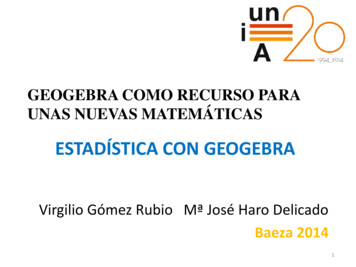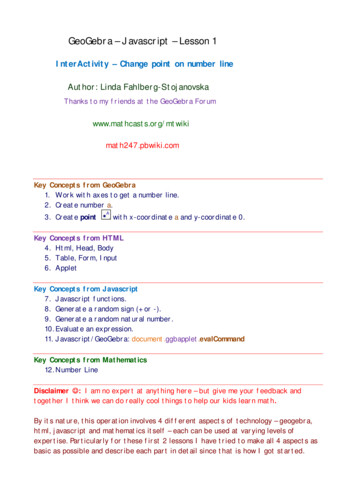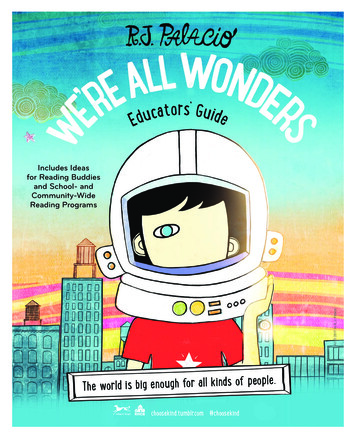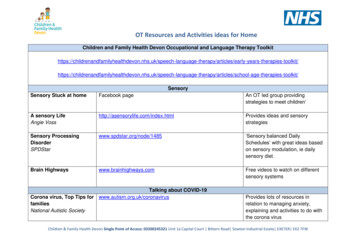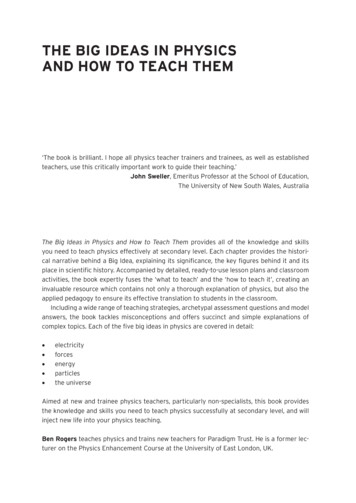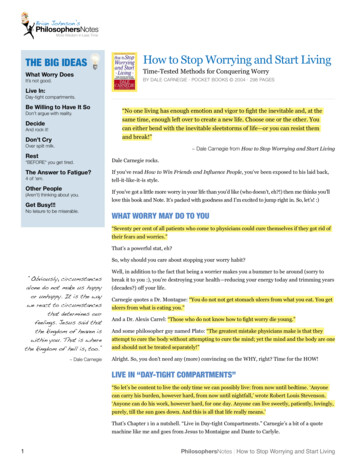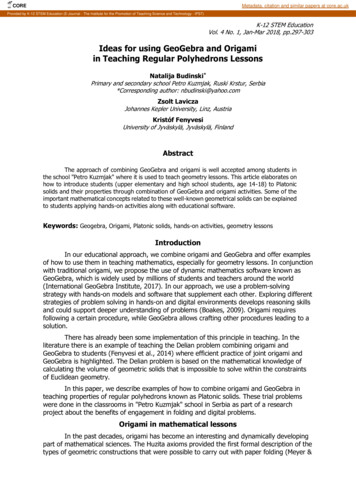
Transcription
COREMetadata, citation and similar papers at core.ac.ukProvided by K-12 STEM Education (E-Journal - The Institute for the Promotion of Teaching Science and Technology - IPST)K-12 STEM EducationVol. 4 No. 1, Jan-Mar 2018, pp.297-303Ideas for using GeoGebra and Origamiin Teaching Regular Polyhedrons LessonsNatalija Budinski*Primary and secondary school Petro Kuzmjak, Ruski Krstur, Serbia*Corresponding author: nbudinski@yahoo.comZsolt LaviczaJohannes Kepler University, Linz, AustriaKristóf FenyvesiUniversity of Jyväskylä, Jyväskylä, FinlandAbstractThe approach of combining GeoGebra and origami is well accepted among students inthe school "Petro Kuzmjak" where it is used to teach geometry lessons. This article elaborates onhow to introduce students (upper elementary and high school students, age 14-18) to Platonicsolids and their properties through combination of GeoGebra and origami activities. Some of theimportant mathematical concepts related to these well-known geometrical solids can be explainedto students applying hands-on activities along with educational software.Keywords: Geogebra, Origami, Platonic solids, hands-on activities, geometry lessonsIntroductionIn our educational approach, we combine origami and GeoGebra and offer examplesof how to use them in teaching mathematics, especially for geometry lessons. In conjunctionwith traditional origami, we propose the use of dynamic mathematics software known asGeoGebra, which is widely used by millions of students and teachers around the world(International GeoGebra Institute, 2017). In our approach, we use a problem-solvingstrategy with hands-on models and software that supplement each other. Exploring differentstrategies of problem solving in hands-on and digital environments develops reasoning skillsand could support deeper understanding of problems (Boakes, 2009). Origami requiresfollowing a certain procedure, while GeoGebra allows crafting other procedures leading to asolution.There has already been some implementation of this principle in teaching. In theliterature there is an example of teaching the Delian problem combining origami andGeoGebra to students (Fenyvesi et al., 2014) where efficient practice of joint origami andGeoGebra is highlighted. The Delian problem is based on the mathematical knowledge ofcalculating the volume of geometric solids that is impossible to solve within the constraintsof Euclidean geometry.In this paper, we describe examples of how to combine origami and GeoGebra inteaching properties of regular polyhedrons known as Platonic solids. These trial problemswere done in the classrooms in "Petro Kuzmjak" school in Serbia as part of a researchproject about the benefits of engagement in folding and digital problems.Origami in mathematical lessonsIn the past decades, origami has become an interesting and dynamically developingpart of mathematical sciences. The Huzita axioms provided the first formal description of thetypes of geometric constructions that were possible to carry out with paper folding (Meyer &
Natalija Budinski, Zsolt Lavicza, Kristóf FenyvesiMeyer, 1999). Mathematical axiomatization of origami put many geometrical constructionsthat were previously impossible to solve, to the straight ruler and compass through thesolution (Auckly & Cleveland, 1995).The definition of origami implies that paper should be folded without using scissorsand glue, and it should result in avariety of forms that we use in everyday life. It is shownthat origami could be beneficial for mathematics teaching as, among other reasons: 1)students feel satisfaction from creation; 2) it blends mathematical vocabulary and contentduring the steps of folding; 3) it supports community building; 4) it encourages cooperativelearning; 5) it develops planar and spatial reasoning; 6) it allows students to create andmanipulate basic geometric shapes with ease; 7) it contributes to the students' cognitivedevelopment; 8) and it offers affordable uses in classrooms.It is also known that origami contributes to students' understanding of mathematicalconcepts, especially concepts related to geometry. Educational researchers perceived itsbeneficial influence on teaching and learning geometry (Boakes, 2009; Cipoletti & Wilson,2004; Fenyvesi et al., 2014a; Fenyvesi et al., 2014b; Robichaux & Rodrigue, 2003) and it isgetting significant attention in the educational circles promoting principles of STEAMeducation (Science, Technology, Engineering, Art, and Mathematics). For example, it can beused in teaching topics such as polyhedrons or symmetry, where models can be made byfolding paper and thereby contribute to students’ understanding of the properties of objects.Geogebra and the 3D properties in mathematical lessonsDynamic Geometry Software (DGS) such as GeoGebracan be used to extendinvestigations and foster deeper understanding of a proof (www.geogebra.org). GeoGebra isaccessible and engaging, and helps to encourage students to further explore the geometricalsituation. It also provides possibilities for making and evaluating conjectures and results.GeoGebra, as its name implies, connects algebra and geometry. This software is useful inhigh school education, because many curriculum topics in mathematics are algebraic andgeometrical. In addition, it is easy to use and has many powerful features, as the software isdynamic. There are numerous materials available on the internet that can be easily used inclassrooms and the software is available in many languages, has free access and the opensource nature also contributes to its popularity. More and more accepted in educationalcircles, GeoGebra is developing and adding new features, such as a 3D grapher featuringsurfaces, geometric objects, quadrics and nets.Platonic solids lesson with GeoGebra and OrigamiIn this section, we provide guidelines on how to introduce students to Platonic solidsand how to use origami and GeoGebra during that process. The lesson plan is created withthe idea that the aid of visual imagination can be helpful to students while discovering factswithout acquiring formal definitions or concepts (Hibert & Cohn-Voss, 1999). Also, this typeof lesson should guide students through geometry and spatial relations. Manipulation ofpaper and assembling physical models, together with GeoGebra and its dynamic and 3Dproperties should open a mathematical discourse and encourage students to explore andlearn.The lessons should start with a short introduction about Platonic solids, which havean interesting and intriguing history, not only mathematical but also philosophical andartistic. Also, students should know that there are only five Platonic solids: tetrahedron,cube, octahedron, dodecahedron and icosahedron. The simplest is the tetrahedron,consisting of four equilateral triangle faces. The six square face solid is well-known as acube or hexahedron. Eight equilateral triangular faces form the octahedron, while anicosahedron consists of twenty. The dodecahedron has twelve regular pentagon faces.These solids, labeled Platonic, were named after the ancient philosopher Plato, who298K-12 STEM Education
Ideas for using GeoGebra and Origamiin Teaching Regular Polyhedrons Lessonsassociated them with classical elements such as earth, air, water and fire. Figure 1 presentsfive Platonic solids made by origami techniques.Figure 1. Five Platonic solids made by origami techniques: (L-R) tetrahedron,dodecahedron, octahedron, cube and icosahedronIn the main part of the lessons students should learn about properties of Platonicsolids and polyhedrons in general. GeoGebra may be used in the introductory part wherestudents are introduced to basic notions connected to polyhedrons such as faces (polygonsof which the polyhedron is consisted), vertices (the segments where faces meet) and edges(the points where vertices meet). The prior made applets can be used for that purpose. Anexample of one of the applets found at GeoGebraTube is shown in Figure 2.Figure 2. Geogebra applet about Platonic solidsVol. 4, No. 1, Jan-Mar 2018299
Natalija Budinski, Zsolt Lavicza, Kristóf FenyvesiAlso, it can be visualized with help of GeoGebra and 3D options as can be seen inFigure 3. Geogebra can also be useful for reminding students of the regular polyhedrons’definitions.Figure 3. GeoGebra representation of Platonic solids made by studentsStudents can receive instructions on paper folding before the lessons. An example ofone of the instructions, folding a tetrahedron unit, is shown in Figure 4. Also, students canfollow YouTube tutorials about Platonic solids paper folding.Figure 4. Instructions for folding tetrahedron unitsAs certain skills in paper folding are required, parts or models made beforehandcould be provided during the lesson to make the process more efficient. As homework,students can assemble some sophisticated models prior to the lesson. There are many waysof folding paper origami models, but we propose techniques recommended by Glassner(1996). The property of convexity can be conveyed through the observation of origamimodels. By observing models, students can conclude that regular polyhedrons are convex.Also, origami models can be used to check that each vertex of the Platonic solid has thesame number of meeting faces (vertices).The fact that there are only five Platonic solids would be visualized by theconstructed origami model. The proof can be explained by the fact that there are at leastthree faces at each vertex of a solid. That implies that the sum of internal angles at thevertex must be less than 360o. At 360o the shape is flattened. The fact that hexagons cannotbe Platonic solid faces should be mentioned to students. In addition, students should beintroduced to the formulae regarding Platonic solids. Finally, the participants should beintroduced to numerous mathematical facts and formulae regarding Platonic solids. Some ofthem are shown in Table 1. Derivation of those formulae and their applications can beexplained with help of GeoGebra.300K-12 STEM Education
Ideas for using GeoGebra and Origamiin Teaching Regular Polyhedrons LessonsTable 1Formulae related to Platonic solidsPolyhedronFacesNumber lateraltrianglesSquaresEquilateraltriangles46 1 arccos 3 2DodecahedronRegular pentagons8 1 3 arccos 6a 22 3a 23 25 10 5 a 2Volumea3a32 3a315 7 5 3a46a43a2a22aa2Inradius24a6620 5 3 arccos arccos 2 3a 2CircumradiusEquilateraltriangles12Area6 2Icosahedron a 31 545 3a 25(3 5 ) 3a12 a10 2 54a 15 11 52 2 103 (3 5 )a12ConclusionsThe use of GeoGebra in the teaching process is not a new one. The idea of usingorigami in mathematical lessons is recognized as beneficial to the teaching process. Thecombination of these two is getting significant attention, because it is not a very commoneducational practice.Vol. 4, No. 1, Jan-Mar 2018301
Natalija Budinski, Zsolt Lavicza, Kristóf FenyvesiNatalija Budinski holds a master’s degree in mathematics andworks as a teacher in the primary and secondary school PetroKuzmjak in Serbia. The field of her interest is mathematicseducation and teaching mathematical content through origamiactivities. She is promoting the approach by giving workshopsand lectures to students and teachers in her home country, andalso at international conferences. In May 2016 her origamiapproach to mathematical lessons was recognized as one of theten best mathematical education practices in Serbia by theCentre for Science Promotion. She received a Bridgesorganization scholarship for achievement in connectingmathematics with art in education in 2016 in Finland.Zsolt Lavicza received his degrees in mathematics and physicsin Hungary, then began his postgraduate studies in appliedmathematics at the University of Cincinnati. While teachingmathematics at the University of Cincinnati he becameinterested in researching issues in teaching and learningmathematics. In particular, he focused on investigating issues inrelation to the use of technology in undergraduate mathematicseducation. Since then, both at the University of Michigan andCambridge, he has worked on several research projectsexamining technology and mathematics teaching in a variety ofclassroom environments. Currently, Dr. Lavizca is working onnumerous research projects worldwide related to technologyintegration into schools, offering educational research trainingcourses at a number of universities, leading a doctoral programin STEM education at Johannes Kepler University, andcoordinating research projects within the International GeoGebraInstitute.Kristóf Fenyvesi is a researcher of STEAM (Science,Technology, Engineering, Arts and Mathematics) Trans- andMultidisciplinary Learning and Contemporary Cultural Studies inFinland, at University of Jyväskylä’s Department of Music, Artand Culture Studies. Dr. Fenyvesi is the Vice-President of theworld’s largest mathematics, arts and education community, theBridges Organization (www.bridgesmathart.org). In 2016 he wasinvited to the European Mathematical Society’s Committee forRaising Public Awareness. Between 2013-2017 he served asChief Executive Officer of International Symmetry Association(www.symmetry.hu) and in 2008 he started ExperienceWorkshop—International Math-Art Movement for Experienceoriented Education of uckly, D. and Cleveland, J. (1995). Totally real origami and impossible paper folding.American Mathematics Monthly, 102, 215–226.Boakes, N. (2009). Origami instruction in the middle school mathematics classroom: Itsimpact on spatial visualization and geometry knowledge of students.Research inMiddle Level Education Online, 32 (7), 1-12.302K-12 STEM Education
Ideas for using GeoGebra and Origamiin Teaching Regular Polyhedrons LessonsCipoletti, B. and Wilson, N. (2004). Turning origami into the language ofmathematics.Mathematics Teaching in the Middle School, 10 (1), 26-31.Glassner, A. (1996). Or
Platonic solids lesson with GeoGebra and Origami In this section, we provide guidelines on how to introduce students to Platonic solids and how to use origami and GeoGebra during that process. The lesson plan is created with the idea that the aid of visual imagination can be helpful to students while discovering facts without acquiring formal definitions or concepts (Hibert & Cohn-Voss, 1999 .
